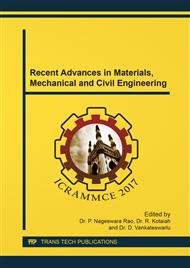[1]
L. Mofor, P. Nuttall and A. Newell, International Renewable Energy Agency, Report on Renewable Energy Options for Shipping Technology Brief, Abu Dhabi, United Arab Emirates, (2015).
Google Scholar
[2]
M. Cames, J. Graichen, A. Siemons, Vanessa Cook, Emission Reduction Targets for International Aviation and Shipping, Policy Department A: Economic and Scientific Policy, European Parliament, B-1047 Brussels, November, (2015).
Google Scholar
[3]
Information on https: /en. wikipedia. org/wiki/Rotor_ship. Retrieved on: 15th July (2016).
Google Scholar
[4]
Information on http: /www. sdtb. de/Flettner-Rotor. 1623. 0. html. Retrieved on: 25th July (2016).
Google Scholar
[5]
A. Thom, The Effect of Discs on the Air Forces on a Rotating Cylinder, Aeronautical Research Committee Reports and Memoranda No. 1623, His Majesty Stationery Office, London, (1935).
Google Scholar
[6]
T. K. Sengupta, A. Kasliwal, S. De, M. Nair, Temporal flow instability for Magnus – Robins effect at high rotation rates, Journal of Fluids and Structures, 17 (2003) 941–953.
DOI: 10.1016/s0889-9746(03)00052-5
Google Scholar
[7]
S. Mittal, Flow past a rotating cylinder: effect of eccentricity, Journal of Applied Mechanics, 68 (2001) 543–552.
DOI: 10.1115/1.1380679
Google Scholar
[8]
Navroz, J. Meena, S. Mittal, Three-dimensional flow past a rotating cylinder, Journal of Fluid Mechanics, 766 (2015) 28–53.
DOI: 10.1017/jfm.2015.6
Google Scholar
[9]
J. F. Wellicome, Some Comments on the Relative Merits of Various Wind Propulsion Devices, Journal of Wind Engineering and Industrial Aerodynamics, 20 (1985) 111-142.
DOI: 10.1016/0167-6105(85)90015-7
Google Scholar
[10]
L. Bergeson, C.K. Greenwald, Sail Assist Developments 1979-1985, Journal of Wind Engineering and Industrial Aerodynamics, 19 (1985) 45-114.
DOI: 10.1016/0167-6105(85)90056-x
Google Scholar
[11]
P. Kindberg, Wind-powered auxiliary propulsion in cargo ships, Bachelor's thesis, Department of Environmental engineering, Helsinki Metropolia University, August, (2015).
Google Scholar
[12]
A. De Marco, S. Mancini, C. Pensa, G. Calise, F. De Luca, Flettner Rotor Concept for Marine Applications: A Systematic Study, International Journal of Rotating Machinery, (2016) 1–12.
DOI: 10.1155/2016/3458750
Google Scholar
[13]
F. M. White, Fluid Mechanics, Tata McGraw Hill, New Delhi, (2008).
Google Scholar
[14]
M. Silvanius, Wind Assisted Propulsion for Pure Car And Truck Carriers, Master Thesis, KTH Centre for Naval Architecture, January (2009).
Google Scholar
[15]
Y. A. Cengel, J. M. Cimbala, Fluid Mechanics, McGraw Hill, New York, (2010).
Google Scholar
[16]
W. S. Janna, Introduction to Fluid Mechanics, CRC Press, New York, (2010).
Google Scholar
[17]
M. Traut, P. Gilbert, C. Walsh, A. Bows, A. Filippone, P. Stansby, and R. Wood, Propulsive Power Contribution of a Kite And a Flettner Rotor on Selected Shipping Routes, Journal of Applied Energy, 113 (2014) 362–372.
DOI: 10.1016/j.apenergy.2013.07.026
Google Scholar


